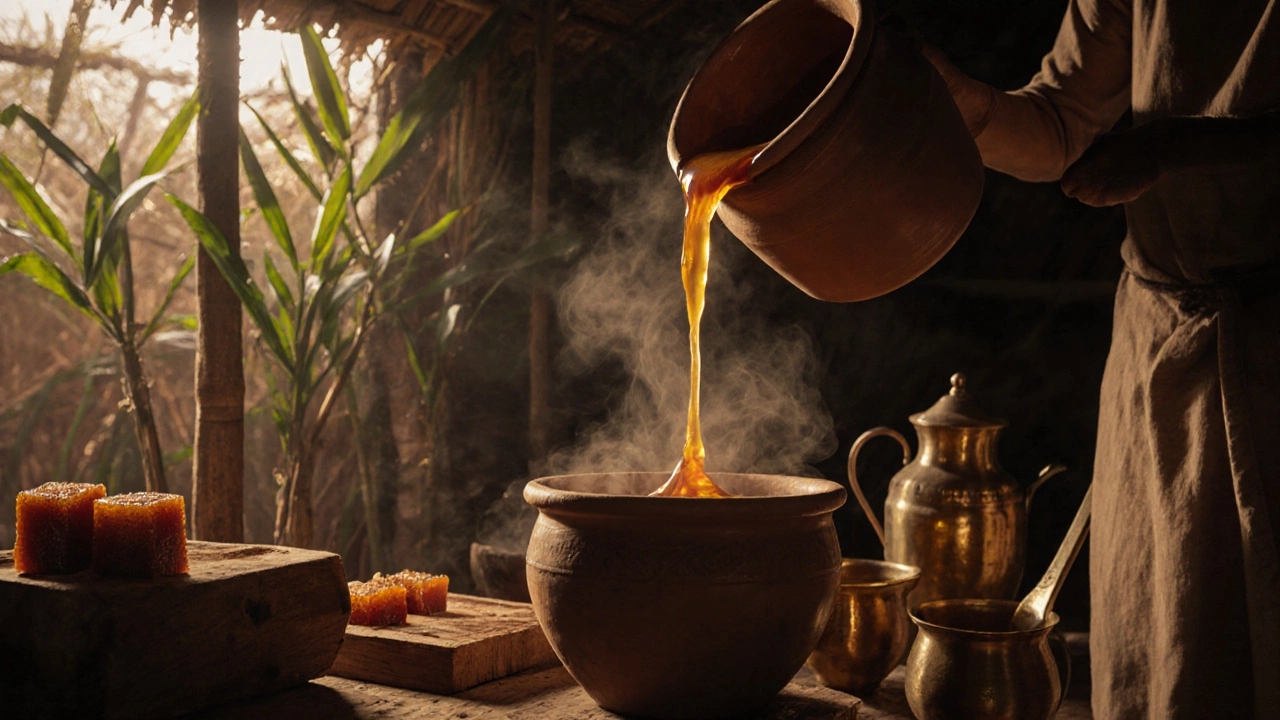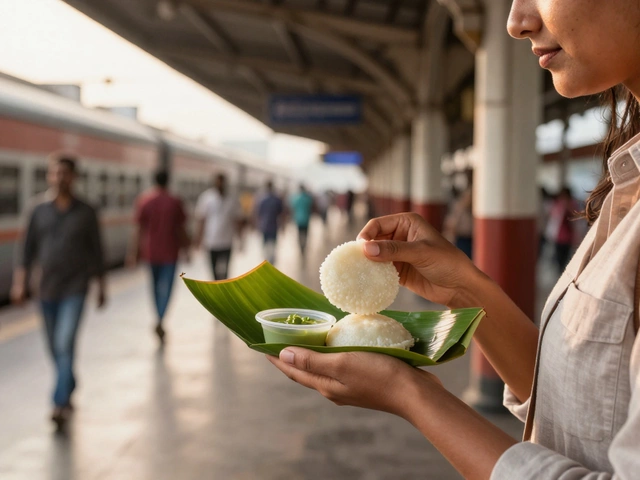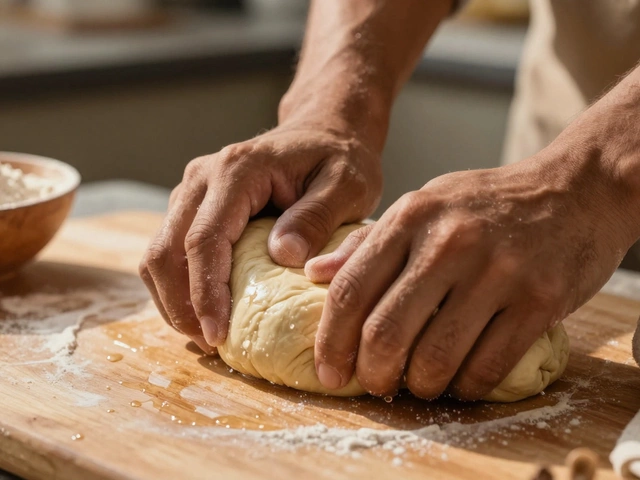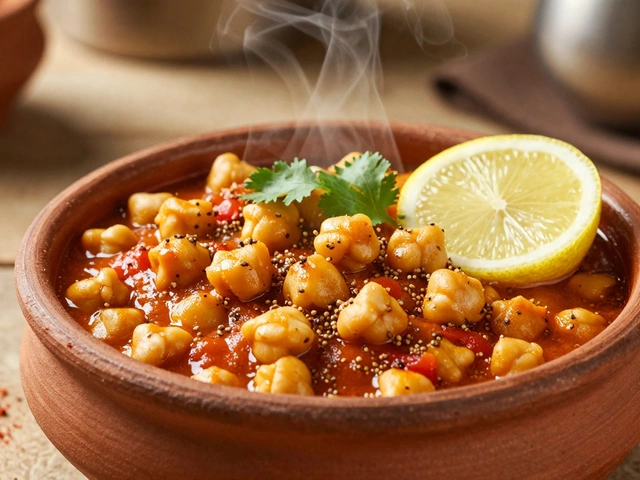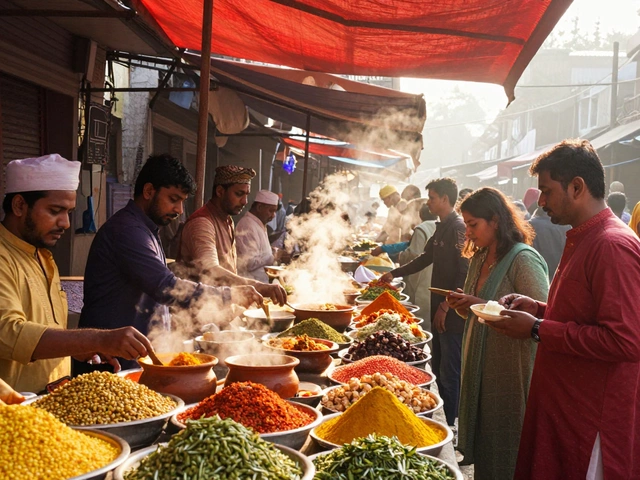Indian Sweetener Identifier Quiz
Test Your Knowledge
How well do you know the sweeteners used in traditional Indian sweets? Answer these questions to see if you can identify the right sweetener based on texture, color, and regional usage.
Question 1
Which sweetener is typically used in traditional North Indian sweets like "gur wale laddoo" and "tilgul"?
Question 2
Which sweetener is naturally present in milk solids (khoya) and requires no added sugar in certain traditional sweets?
Question 3
Which sweetener produces a dark brown color, earthy aroma, and slightly grainy texture in traditional Indian sweets?
Question 4
Which sweetener is most commonly used in commercial packaged sweets like barfi, kheer, and rasgulla in urban areas?
Your Score: 0/4
When you bite into a warm gulab jamun or a sticky jalebi, the sweetness isn’t just sugar. It’s history, region, and tradition rolled into one. In Indian sweets, the sweetener isn’t an afterthought-it’s the foundation. Most people assume it’s white granulated sugar, but that’s not the full story. Across India, different regions use different sweeteners, each bringing its own flavor, texture, and cultural weight.
Jaggery: The Heart of Traditional Indian Sweets
Jaggery, called gur in Hindi, vellam in Tamil, and belgama in Kannada, is the most common sweetener in rural and traditional Indian kitchens. Made from sugarcane juice or palm sap, it’s boiled down until thick, then poured into molds to harden. Unlike refined sugar, jaggery keeps minerals like iron, magnesium, and potassium. That’s why it’s often called desi shakkar-village sugar.
In North India, jaggery is the star in gur wale laddoo, tilgul (sesame and jaggery balls), and gur ki roti. In Maharashtra, it’s mixed with peanuts and coconut for tilgulachi goli, eaten during Makar Sankranti. In South India, palm jaggery-made from toddy palm sap-is used in payasam and adai. It has a deeper, smokier taste than cane jaggery, almost like molasses with a hint of earth.
Why does it matter? Jaggery doesn’t just sweeten-it adds body. It helps sweets hold shape, gives a chewy texture, and imparts a caramel-like depth that white sugar can’t match. In fact, many sweet shops still refuse to use refined sugar for traditional recipes because it changes the flavor profile too much.
White Sugar: The Modern Standard
White granulated sugar became popular in Indian sweets during the 20th century, especially in cities and commercial sweet shops. It’s cleaner, cheaper, and easier to measure. Today, you’ll find it in most packaged sweets like barfi, kheer, and rasgulla sold in supermarkets.
But here’s the catch: white sugar doesn’t caramelize the same way. Sweets made with it tend to be softer, less complex in flavor, and sometimes overly sweet without depth. In places like Kolkata, where rasgulla is a point of pride, many makers still use a mix of sugar and jaggery to get that signature melt-in-mouth texture. Pure white sugar can make the syrup too thin and the balls too fragile.
Commercial producers use white sugar because it’s consistent. But home cooks and artisanal makers know the difference. If you’ve ever tasted a peda from a family-run shop in Mathura, you’ll notice it’s richer, darker, and less cloying than the ones from big brands. That’s the jaggery at work.
Milk Solids: The Hidden Sweetener
Many Indian sweets don’t rely on sugar at all-because they’re made from milk. Khoya (also called mawa) is milk reduced for hours until it becomes a thick, creamy solid. It’s naturally sweet from lactose, the sugar found in milk. When cooked with ghee and cardamom, it turns into khoya barfi, kalakand, or sooji halwa.
Khoya-based sweets are common in North India and are often the centerpiece of Diwali and wedding platters. They’re not just sweet-they’re creamy, dense, and satisfying. In fact, some recipes use no added sugar at all. The sweetness comes entirely from the milk solids. That’s why these sweets last longer without spoiling-the lactose acts as a natural preservative.
What’s surprising? Even in modern kitchens, khoya is still made the old way: by simmering whole milk in a wide, shallow pan for 6-8 hours. No shortcuts. No additives. Just milk, heat, and time.
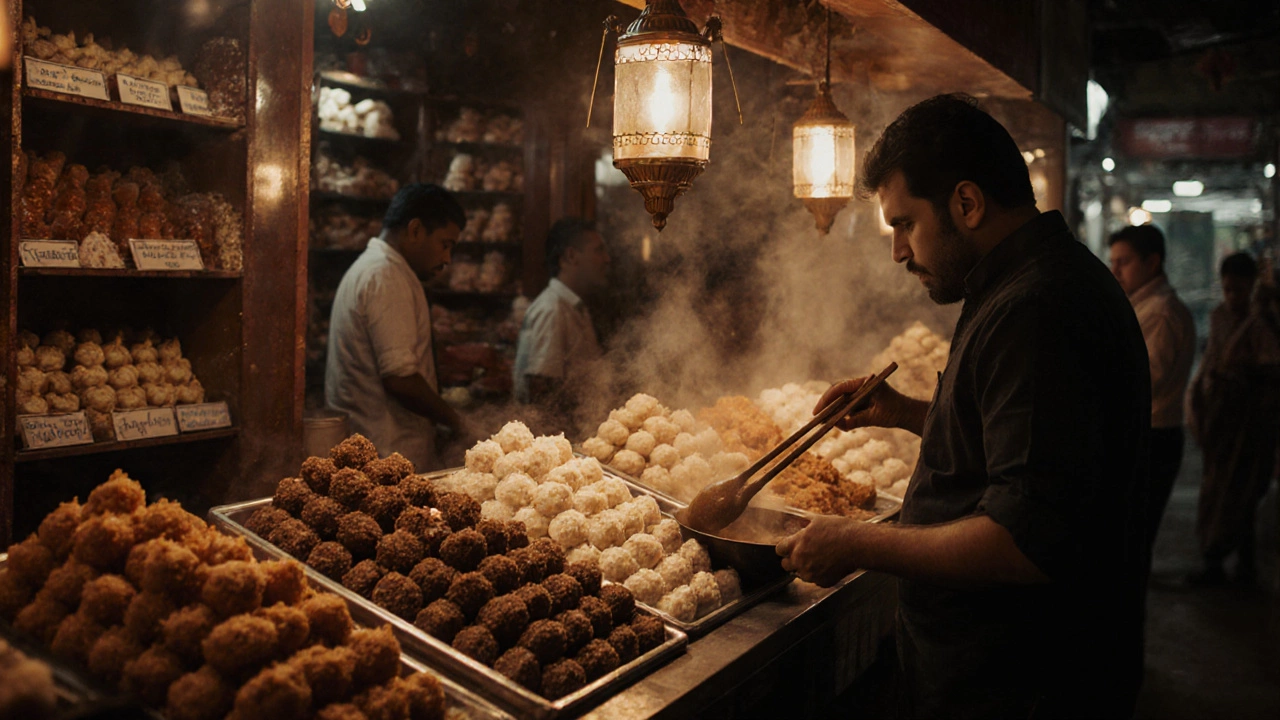
Honey and Date Syrup: The Niche Alternatives
While not traditional, honey and date syrup are slowly making their way into modern Indian sweets, especially in urban health-conscious circles. In Delhi and Bengaluru, you’ll find honey laddoos made with raw honey and roasted gram flour. They’re marketed as ‘Ayurvedic’ or ‘sugar-free’-though honey is still a sugar, just a less processed one.
Date syrup, made by boiling dates into a thick paste, is used in some experimental desserts. It’s common in Middle Eastern sweets but is now being adopted by Indian chefs looking for low-glycemic options. It works well in gulab jamun syrup, adding a fruity depth that jaggery doesn’t have.
But these are exceptions. Most Indian households still stick to what’s been used for generations. Honey is expensive. Date syrup is hard to find outside specialty stores. They’re trendy, but not yet traditional.
Why the Sweetener Choice Matters
The sweetener doesn’t just affect taste-it affects texture, shelf life, and even cultural meaning. Jaggery is tied to festivals, harvests, and seasonal rituals. White sugar is tied to convenience and mass production. Khoya is tied to family recipes passed down for decades.
Try this: Make a batch of besan laddoo with jaggery. Then make another with white sugar. Taste them side by side. The jaggery version will be darker, nuttier, and less sharp. The sugar version will be brighter but flatter. That’s not just preference-it’s chemistry.
Even the syrup for rasgulla changes based on the sweetener. Sugar syrup boils at 100°C. Jaggery syrup, because of its impurities, boils at a lower temperature and takes longer to thicken. That’s why jaggery-based rasgullas are softer and absorb syrup more slowly. The result? A more balanced sweetness that doesn’t overwhelm.
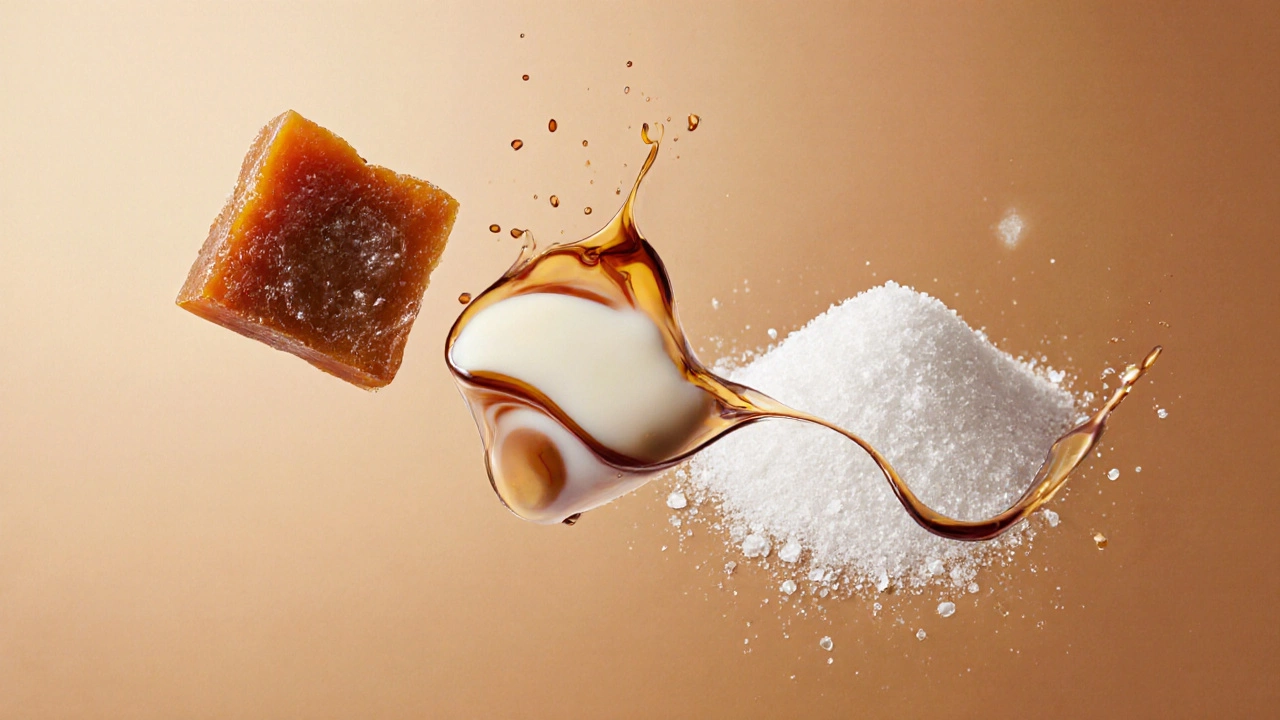
What to Look for When Buying Indian Sweets
If you’re buying Indian sweets, here’s how to tell what sweetener was used:
- Jaggery sweets: Dark brown or amber color, slightly grainy texture, earthy aroma, less sticky than sugar-based sweets.
- Sugar sweets: Pure white or pale yellow, very smooth, often glossy, and overly sweet on the first bite.
- Khoya sweets: Creamy, dense, no visible sugar crystals, melt slowly in your mouth, often have a buttery finish.
Ask the shopkeeper: “Is this made with gur or chini?” (jaggery or sugar). In traditional shops, they’ll know. In chain stores, they might not care.
Can You Substitute One for Another?
You can, but it’s not a 1:1 swap. Jaggery is 70-80% sucrose, with the rest being minerals and water. White sugar is 99.9% sucrose. So if you replace sugar with jaggery in a recipe, you’ll need less volume-about 20% less-and you’ll need to adjust the liquid content because jaggery adds moisture.
Khoya can’t be swapped for sugar at all. It’s not a sweetener-it’s a base ingredient. If you try to use it in place of sugar in syrup, it’ll curdle.
Best practice: Stick to the traditional sweetener in the recipe. If you’re making gur ka ladoo, use jaggery. If you’re making barfi, use sugar. If you’re making kalakand, use khoya. Don’t guess. The flavor changes too much.
Final Thought: It’s Not About Sugar-It’s About Culture
Indian sweets aren’t just desserts. They’re offerings, gifts, celebrations. The sweetener tells you where the sweet came from. A jaggery-based sweet from rural Bihar is different from a sugar-based one from Mumbai. One carries the scent of harvest fields. The other carries the hum of a factory line.
Next time you eat an Indian sweet, pause before you swallow. Taste the sweetness-but also taste the story behind it.
